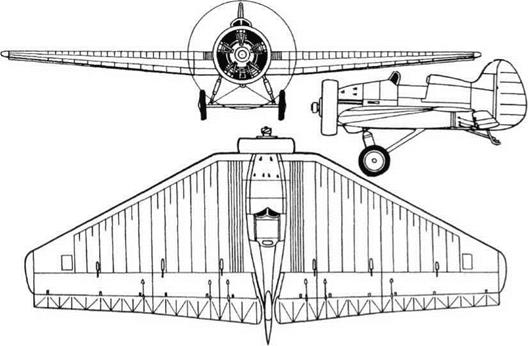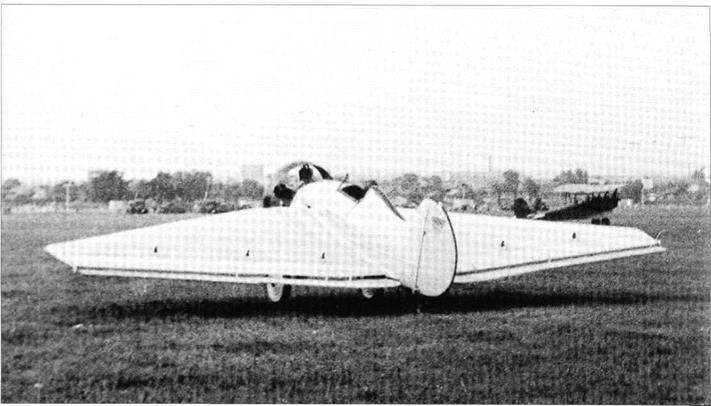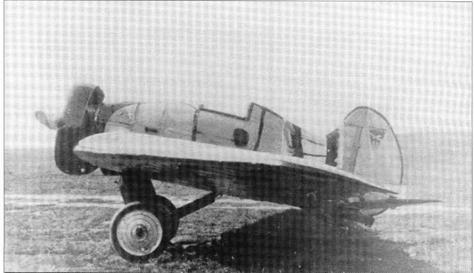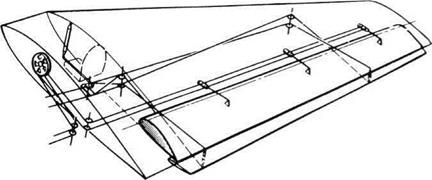BOK-5
Purpose: To experiment with a tailless (so – called ‘flying wing’) design.
Design Bureau: Bureau of Special Design, Smolensk. Design team led by V A Chizhevskii.
The idea for this small research aircraft came from the BOK-2, though the two aircraft were completely unrelated. In 1935 Chizhevskii began studying tailless aircraft, and obtained funding to build a simple research aircraft. This was completed in early 1937, but was then modified and did not fly until September, the pilot being I F Petrov. It ‘flew satisfac- torily…but crashed during a landing’. After being repaired and modified its handling qualities were greatly improved. In 1938 the
modified aircraft was tested by the Nil WS (air force flight-test institute), where it was flown by such pilots at P M Stefanovskii and M A Nyukhtikov. Stefanovskii is reported to have said that the BOK-5 could be ‘flown by pilots of average or even below average ability’ and to have been ‘impressed by its acrobatic capability’.
The BOK-5 was a basically simple aircraft, apart from the flight-control system. The airframe was made of duralumin. The wing was ofCAHI (TsAGI) 890/15 profile (15 per cent t/c ratio), with two spars with tubular booms and sheet webs, and ribs assembled from channel and angle sections, with fabric covering. The short fuselage was a semi-monocoque, with some box-section longerons and
pressed-sheet frames, the vertical tail being integral. The main landing gears were described as ‘U-2 type’. On the nose was a 1 00hp M-l 1 engine in a Townend-ring cowl, driving a two-blade metal propeller.
Modifications concentrated on the trailing – edge controls. According to Shavrov there were three movable surfaces on each wing, extending over 21 per cent of the chord. The outermost was a rectangular aileron, and the two inboard surfaces acted in unison as elevators. Most photographs and drawings show these surfaces as simple one-piece units hinged to brackets below the trailing edge and with a neutral setting of-5°. However, recently a drawing (reproduced here) was discovered showing the main surfaces operated
|


by servo action. The pilot’s control cables can be seen to drive a narrow-chord servo control which in turn moves the main surface. The neutral setting of the main surfaces can be seen to be adjusted by a longitudinal-trim wheel with cables to screw-jacks.
The BOK-5 was clearly a safe aircraft which impressed two of the Soviet Union’s best test pilots, but it remained a one-off which was soon forgotten.
|
Dimensions Span Length Wing area |
9.86m 4.365m 23.15m2 |
32 ft 4Л in 14 ft 4 in 249ft2 |
|
Weights |
||
|
Empty |
596kg |
1,314 Ib |
|
Fuel |
90kg |
198 Ib |
|
Loaded |
764kg |
l,684lb |
|
Performance |
||
|
Maximum speed |
174km/h |
108 mph |
|
Take-off run |
120m |
394ft |
|
Service ceiling |
4,850 m |
15,900ft |
|
Range |
600km |
373miles |
|
Endurance |
4 hours |
|
|
Landing speed/ |
85km/h |
53 mph |
|
run |
200m |
656ft |
Top and centre: Two views of BOK-5.

 Bottom: BOK-5 servo control.
Bottom: BOK-5 servo control.










